Discuss the Relationship of Abstract Expressionism to the Styles of Minimalism and Pop Art
The primary difference between impressionism and expressionism is that impressionism emerged during the late xixthursday century in Paris whereas expressionism emerged during the early 20th century in Frg and Austria. Moreover, impressionist artists paid special attention to the depiction of the impression of low-cal and its irresolute effect whereas expressionist artists paid special attending to the depiction of emotion the field of study arouses in the artist.
Impressionism and Expressionism are fine art movements that appeared around the 20thursday century in Europe. Both focus on painting styles.
Key Areas Covered
one. What is Impressionism
– Definition, Characteristics, Artists
2. What is Expressionism
– Definition, Characteristics, Artists
three. What are the Similarities Between Impressionism and Expressionism
– Outline of Common Features
four. What is the Difference Betwixt Impressionism and Expressionism
– Comparison of Key Differences
Key Terms
Art, Expressionism, Impressionism, Literary Movements, Painting Styles

What is Impressionism
Impressionism is an art movement that originated in the late 19th century in Paris as an artistic reaction to the rapidly changing urban environment. The movement also marked a momentous break from tradition in European painting. Impressionists were harshly criticized by the conventional artists in French republic. Still, later on on, this art motility was highly admired and loved.
The name impressionism is derived from the title of Claude Monet'southward painting Impression, Soleil levant (Impression, Sunrise). The impressionist fashion of painting is considered a spontaneous method of painting in which an creative person attempts to capture the impression of light in a scene.
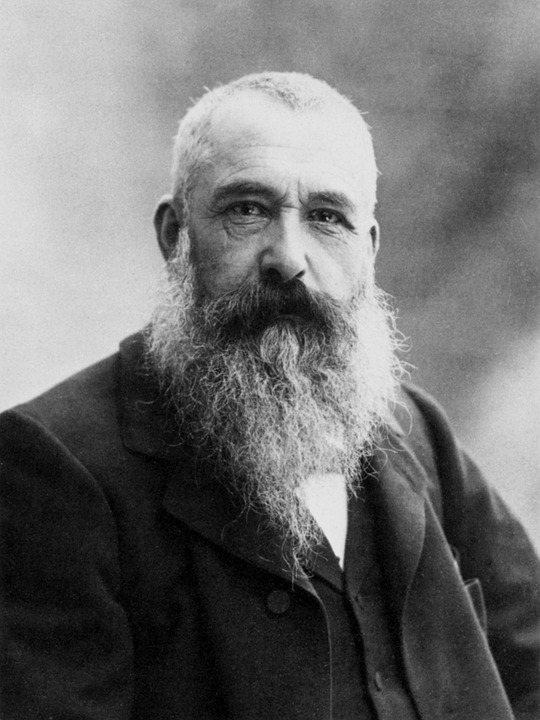
Figure 1: Claude Monet
Moreover, a distinguishing feature of impressionist paintings is their painting way that rejected the traditional realist style. The impressionists incorporated new scientific experiments into the use of colour to attain a more exact representation of color and tone. They used a more optical method equally they mixed the unblended pigments to create a nebulous blend of pure colour.
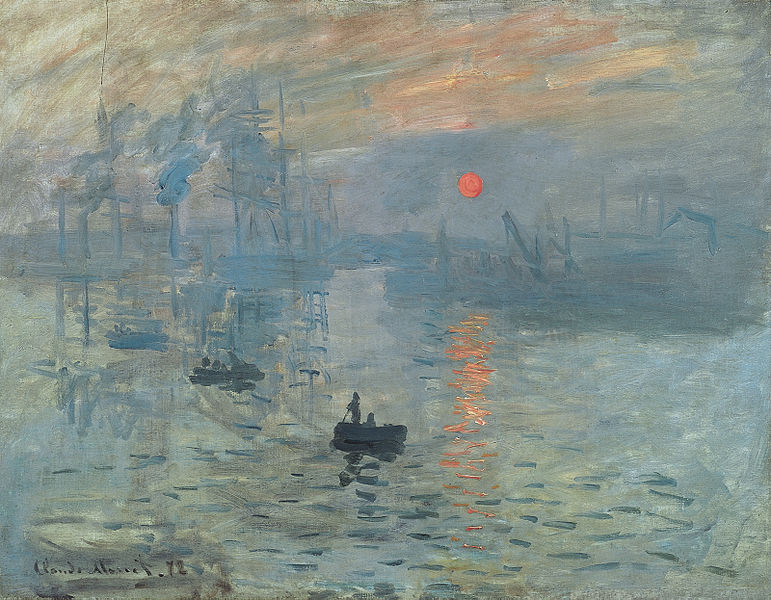
Effigy 2: Claude Monet's painting Impression, Soleil Levant
Emphasizing the subject'due south gaze in their paintings, impressionists also explored thetheme of isolation in a newly crowded society through their subject's gaze. Some famous impressionist artists are Claude Monet, Camille Pissarro, Alfred Sisley, Édouard Manet, and Armand Guillaumin.
Characteristics of Impressionism
The impressionist artists focus mainly on
- Vibrant colors rather than mixing them
- Spontaneous brushstrokes in broad strokes, either using a painting knife or a castor,
- Emphasis on authentic depiction of light forth with its changing quality
- Unusual visual angles
- Subjects from the modernized urban life
- Candid poses and compositions of subjects
Thus, this method helped the artists to highlight the impression of their object, more than than painting the object in a realistic manner.
Moreover, impressionism enabled the artists to paint an image in such a fashion that the spectator would feel they only got a glimpse of the image subject.
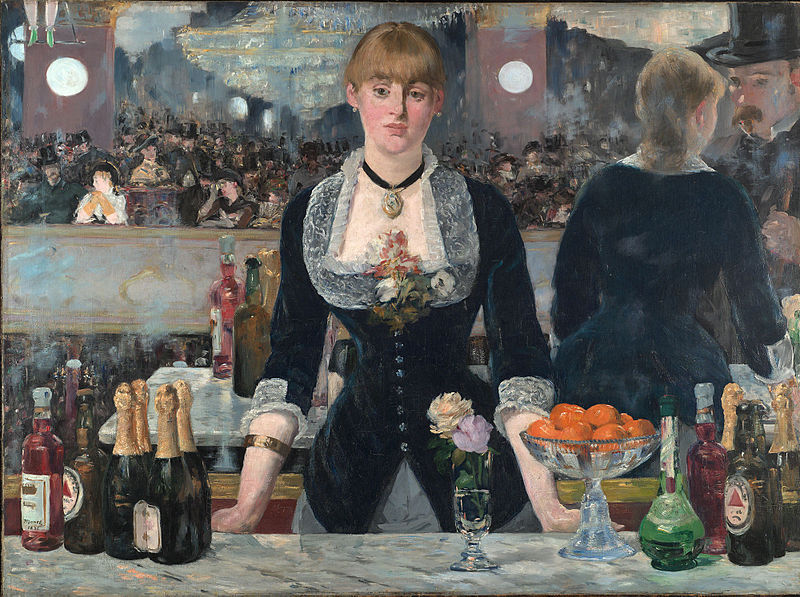
Figure iii: Edouard Manet'due south Un bar aux Folies Bergere (A bar at the Folies Bergeres)
Most paintings in impressionism are outdoors capturing realistic scenes of modern life painted in vibrant colors without an emphasis on detail.
What is Expressionism
Expressionism is an art movement that originated in the early twentyth century in Germany and Austria, likewise as an creative response to the dehumanizing effects resulting from industrialization. In this art mode, the artist attempts to depict subjective emotions and responses that objects and events agitate in him, instead of objective reality. Thus, this art is a reaction to positivism and other artistic styles such equally Naturalism and Impressionism.
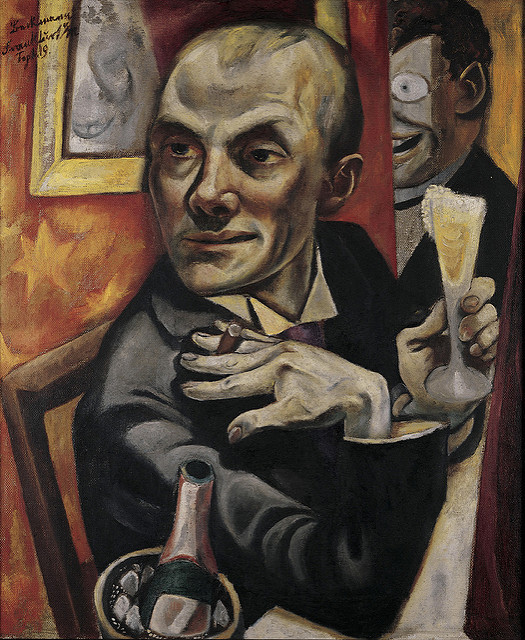
Figure four: Max Beckmann' due south cocky-portrait with Champagne glass
The term expressionism has its origin in the paintings exhibited by Julien-Auguste Hervé in 1901 in Paris, which he calledExpressionismes. In that location are distinct creative characteristics in expressionism that makes it unlike from other styles. Different impressionist paintings, expressionist paintings are total of vivid imagery and emotion, and they are frequently described equally showing a touch on of the dark side of human nature. The use of distorted and agitated brushstrokes signify the emotional upshot in these paintings.
Hence, these paintings nowadays the world solely from a subjective perspective and distort the subject matter radically for emotional effect in order to evoke moods or ideas and to create an emotional upshot. Moreover, these artists used arbitrary colors in their works, significant subjects were depicted in colors that had no natural relation to them (a dark-green face, an orange heaven, etc.).

Figure 5: Edvard Much's The Scream
Also, expressionist painters bear witness their emotions and personal views of their work. They portray subjective reality rather than realism. Artists who paint in this manner also incorporate fantasy and violence in their discipline thing in order to show the extremity of emotions. Some well-known expressionist artists are Ernst Ludwig Kirchner, Georges Rouault, Max Beckmann, August Macke, Paul Klee, Marc Chagall, Edvard Munch, and Wassily Kandinsky.
Characteristics of Expressionism
The distinguishing painting characteristics of expressionist art are
- Agitated or gestural and distorted brushstrokes to convey extreme emotions
- Utilize of intense and capricious bold color with solid hues
- Often subjects were depicted in colors that had no natural relation to them. Moreover, artists similar Wassily Kandinsky fifty-fifty assigned colors to unlike feelings (red for joy, yellow for anger, etc.).
- Disjointed spaces and distorted subject area matters – this is used to illustrate new anxieties and isolation in urban life.
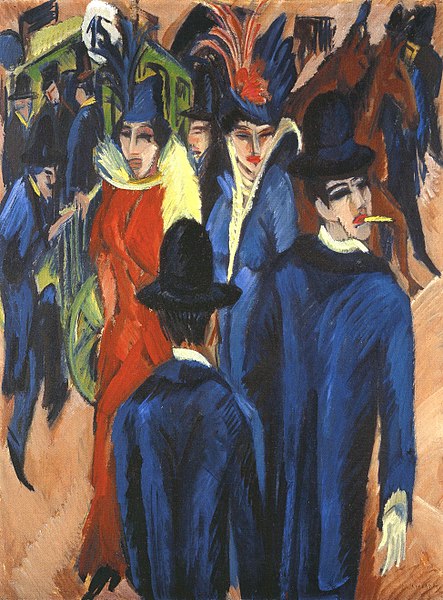
Figure half dozen: Ernst Ludwig Kirchner'south Berlin Street Scene
Expressionist paintings are characterized by distortion and exaggeration in order to create an emotional effect.
Similarities Between Impressionism and Expressionism
- Impressionism and Expressionism are art movements that emerged during the belatedly 19 to the early on twentythursday century every bit an artistic response to the changing modernized, industrialized man lifestyles.
- Both art movements had similar themes as a response to the effects of modernized, industrialized human lives such as isolation, dehumanization of homo lives, etc.
- Too, Impressionism and Expressionism both emerged as opposition to realism and naturalism.
Difference Betwixt Impressionism and Expressionism
Definition
Impressionism is an art motility that originated in the belatedly 19th century in Paris equally an artistic reaction to the rapidly changing urban surround. On the other paw, Expressionism is an art motion that originated in the early on 20th century in Germany and Austria as an artistic response to the dehumanizing effects resulting from industrialization. Thus, this is the chief difference between Impressionism and Expressionism.
Characteristics
Significant characteristics in impressionism include the use of vibrant colors, harsh and spontaneous brushstrokes, authentic delineation of light with its irresolute quality, use of unusual visual angles, and the apply of subjects from the modernized urban life. In dissimilarity, significant painting characteristics in expressionism include the utilise of intense and arbitrary colors with solid hues, agitated or gestural brushstrokes to convey extreme emotions, disjointed spaces, distorted discipline, and the use of discipline matters from industrialized urban life. Hence, this is a major difference between Impressionism and Expressionism.
Artists
Some famous artists in impressionism are Claude Monet, Camille Pissarro, Alfred Sisley, Édouard Manet, Armand Guillaumin, etc. while some famous artists in expressionism are Ernst Ludwig Kirchner, Georges Rouault, Max Beckmann, August Macke, Paul Klee, Marc Chagall, Edvard Munch, Wassily Kandinsky, etc. This is another difference between Impressionism and Expressionism.
Conclusion
Both impressionism and expressionism are art movements that happened during the 20th century in Europe. Impressionism emerged during the late xixth century in Paris whereas expressionism emerged during the early on xxth century in Germany and Austria. Even though at a glance they do appear similar styles of paintings, they accept distinguishable characteristics and styles. Thus, this is the difference between Impressionism and Expressionism.
Reference:
one. "Impressionism." Art Movements, Available here.
2. Habicht, Clemens, and Shovova. "How Impressionism Changed the Fine art Globe and Continues to Inspire Us Today." My Mod Met, 27 June 2018, Bachelor hither.
3. "Impressionism." Wikipedia, Wikimedia Foundation, 5 Feb. 2019, Available here.
4. "Expressionism." Wikipedia, Wikimedia Foundation, i February. 2019, Available here.
five. "Expressionism." Art Movements, Available here.
Image Courtesy:
i. "62934" (CC0) via Pixabay
2. "Claude Monet, Impression, soleil levant" By Claude Monet – wartburg.edu (Public Domain) via Commons Wikimedia
3. "Edouard Manet, A Bar at the Folies-Bergère" Past Édouard Manet – Museum page (Public Domain) via Commons Wikimedia
iv. "[ B ] Max Beckmann – Self-portrait with Champagne Glass (1919)" Past cea + (CC By 2.0) via Flickr
5. "Edvard Munch – The Scream – Google Fine art Project" Past Edvard Munch – Google Art Project (Public Domain) via Commons Wikimedia
half-dozen. "Kirchner Berlin Street Scene 1913" By Ernst Ludwig Kirchner – Scanned by uploader from the catalog: Deborah Wye, Kirchner and the Berlin Street, New York, MoMA, 2008. ISBN 9780870707414 (Public Domain) via Commons Wikimedia

christensenbrobbegreare.blogspot.com
Source: https://pediaa.com/what-is-the-difference-between-impressionism-and-expressionism/
0 Response to "Discuss the Relationship of Abstract Expressionism to the Styles of Minimalism and Pop Art"
Post a Comment